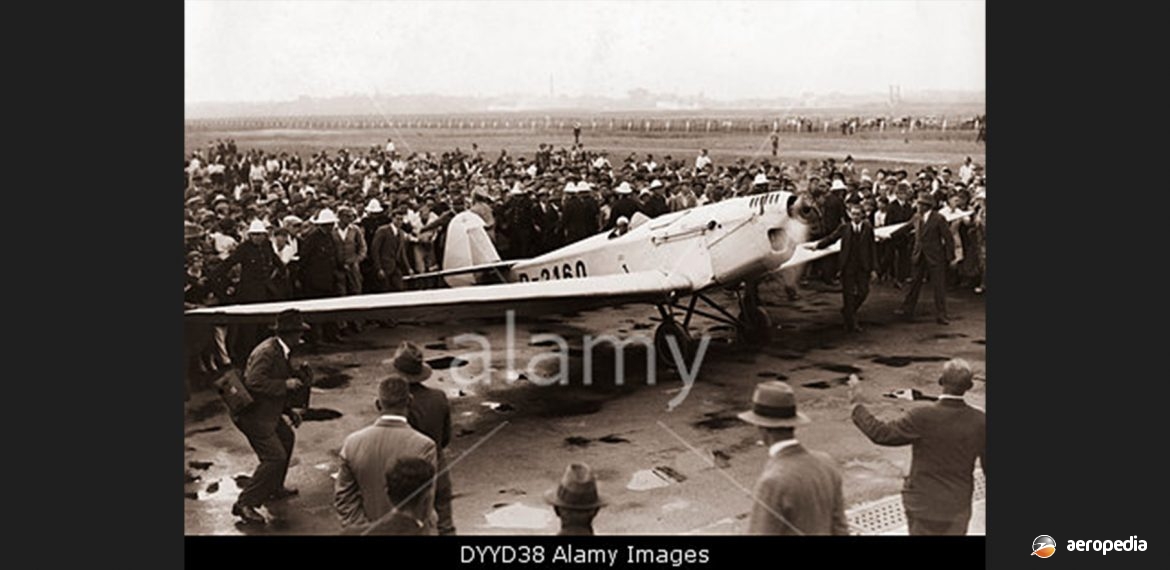Photograph:
Elly Beinhorn arriving at Darwin, NT in on 22 March 1932 in the Kl.26aV D-2160 (Northern Territory Library)
Country of origin:
Germany
Description:
Two-seat light training and sport monoplane
Power Plant:
One 70 kw (95 hp) Argus As 8 O 2 four-cylinder in-line air-cooled engine
Specifications:
- [L 25e V]
- Wingspan: 13.0 m (42 ft 7 in)
- Length: 7.45 m (24 ft 5 in)
- Height: 2.05 m (6 ft 6 in)
- Wing area: 20 m² (215.28 sq ft)
- Max speed: 175 km/h (109 mph)
- Service ceiling: 5,400 m (17,717 ft)
- Range: 515 km (320 miles)
- Empty weight: 520 kg (1,146 lb)
- Loaded weight: 900 kg 1,984 lb)
History:
The Klemm L.26 was one of a series of light aircraft produced at the conclusion of World War I. It was designed by Dr Ing Hans Klemm for the Daimler Aircraft Company in Stuttgart. In 1924 Klemm founded his own company at Boeblingen known as the Klemm Leichtflugzeugbau GmbH. The first successful design was the L.25 flown in 1927 with a 15 kw (20 hp) Mercedes engine, and about 600 examples were completed. A larger development of this model was the L.26 introduced in 1929 which was fitted with an Argus As-8 O 2 engine. This was produced in a number of models, the L.26e V having an Argus As-8 engine providing 90 kw (120 hp). A three seat variant was known as the VL.26. About 170 examples were completed in Germany. The series was used by Elly Beinhorn and Ernst Udet for a number of record flights. The L.26 was a low wing monoplane of wood and fabric construction.
Fraulein Elly Beinhorn [30 May 1907 to 25 November 2007] was the daughter of a German industrialist, learnt to fly in 1928 and went aerobatic barnstorming. In 1931 she made her first significant solo flight to Portuguese Guinea (which later became Guinea Bissau) in West Africa in support of a German scientific expedition but the engine of her aircraft developed an oil leak and crashed in the Sahara desert. With assistance she hiked to Timbuktu and eventually returned to recover some parts from her aircraft.
On 4 December 1931 the 24 year old German aviatrix left Heimathfen Staaken, 18 km NW of Tempelhof, Berlin in a Kl.26aV with a 90 kw (120 hp) Argus powered machine to fly to Australia. She flew via Budapest, Sofia, Istanbul, Allepo, Baghdad, Bushire, Djsak, Karachi, Delhi, Allahabad, Calcutta, Akyab, Rangoon, Bangkok, Victoria Point, Singapore, Batavia, Surabaya, Bima, Kupang, Port Darwin, Newcastle Waters, Cloncurry, Longreach, Charleville and Brisbane to Sydney, arriving at Mascot on 4 April 1932.
Painted on the tail of the aircraft during the trip was “Elly Beinhorn, Berlin, Germany, Heimathfen Staaken” her home aerodrome which was 18 km north-west of Tempelhof in Berlin.
At Bushire in Persia the aircraft suffered mechanical problems and she met up with Moye Stephens, an American, travelling in a Stearman C-3B biplane named ‘the Flying Carpet’ with travel writer Richard Halliburton, who were flying around the world. She then flew with them to Mount Everest. As part of the trip she was accompanied by three Supermarine Southampton flying boats of No 204 Squadron, Royal Air Force.
The aircraft was taken into the city of Sydney and displayed for two weeks in the Grace building before it was dismantled and shipped to New Zealand. There Ms Beinhorn became an honorary member of the Wairarapa Aero Club. She visited Pitcairn Island and the aircraft was then shipped to Panama, South America where, after re-assembly, further flying was carried out. This section of the trip included Colombia and Peru. She had an oxygen supply set up in the aircraft before flying over the Andes.
In Brazil the aircraft was dismantled and shipped to Germany, where she arrived in June 1932. She was subsequently awarded the Hindenburg Cup and a sum of 10,000 German Marks.
She made a number of other long-distance flights in later years, including to Africa in a Heinkel He 71, flights in a Heinkel He 64 D-2305, and flights in a Messerschmitt Bf 108. In Hamburg, Germany, a Messerschmitt Bf 108 D-EBEI owned by the Lufthansa Historic Flight has her name painted on each side of the engine cowling.
Ms Beinhorn wrote a book in 1935 of her experiences called ‘Flying Girl’, the foreword being written by Richard Halliburton. In 1936 she married Bernd Rosemeyer, a well known Audi racing driver of the time, and had a son Bernd Junior, but her husband died when testing an Auto Union Streamliner racing car shortly thereafter. She later married Dr Karl Wittman and had a daughter Stephanie. In 1967 she was brought to Australia by Qantas and gave a number of talks about her flying, visiting a number of centres she had visited in the historic 1932 flight. In Sydney she gave a talk to members of the Aviation Historical Society of Australia. She survived to 100 years of age.
Production of the Klemm series of light aircraft also took place in the United States by the Aeromarine-Klemm Company which built about 120 aircraft. Variants built included the AKL.25, AKL.26, AKL.27, AKL.60, AKL.70 and the Model 70 Trainer.

